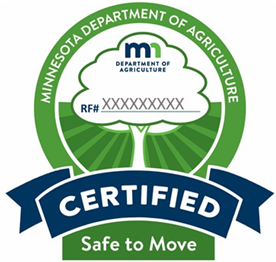Firewood for Consumers

Many pest species live on or in trees, lumber, and firewood. Moving untreated firewood can spread pests and affecting the health of Minnesota’s trees and forests. Emerald ash borer, spongy moth, and Asian longhorned beetle are examples of invasive species that have killed millions of trees across the US. Other native pests like: wood borers, bark beetles, and carpenter ants can also move on un-treated firewood causing problems for homeowners. If you have any questions regarding safe to move firewood or suspect a tree has a reportable pest contact the MDA’s Report a Pest at reportapest@state.mn.us or 888-545-6684.
How You Can Protect our Forests
- Don’t transport firewood. Buy it close to where it will be burned. Locally purchased wood is less likely to contain pests not already in the area.
- Buy MDA certified heat-treated firewood. Certified firewood poses the lowest risk of carrying pests and is identified by the MDA certified logo on the label.
- Make sure it is labeled with the required information – look for county of harvest location. [link to labeling laws]
- If visiting a Minnesota State Park, please follow Department of Natural Resources firewood guidelines for park visitors.
- Burn it quickly, and don’t store it for long periods of time.
If You Have Your Own Firewood
- Burn it close to where it was harvested
- Burn firewood used for home heating before spring to prevent pests from emerging. Insects and diseases attack trees during the growing season in Minnesota.
- Try to cut new wood in mid to late fall reducing the risk of attracting spring time borers.
- Stacking wood off the ground and promoting good air circulation will increase drying and reduce potential pest problems.
- Not storing wood inside the home for long periods of time
Restrictions on Firewood Movement

The Minnesota Department of Agriculture (MDA) regulates pests so they aren’t spread to new areas by human activities. To accomplish this, pest quarantines have been established to limit the movement of hardwood firewood. It is illegal to transport hardwood firewood out of Minnesota quarantined counties unless it is MDA certified. It is also illegal to transport hardwood firewood into Minnesota from all other states. Moving uncertified hardwood firewood outside of a regulated area is illegal and is punishable up to a $7,500 fine per violation per day.
More Firewood Information
All state-certified wood materials will have the state certificate on the label. Certified materials have been processed or treated according to the state regulations before crossing quarantine boundaries.
- Firewood is certified by the MDA and displays the appropriate label information.
- Is unopened ?
- Firewood bundles have been opened
- Firewood is not certified as treated
- Firewood bundles fail to display the appropriate certification shield.
Firewood Pests and Diseases
- Emerald ash borer is a non-native insect that has killed millions of ash trees since 2002 when it was accidentally introduced into Michigan from China. This invasive insect is spreading to other states and Canadian provinces due to the movement of infested firewood and nursery stock. Emerald ash borer has been found in Minnesota and firewood could further spread this destructive pest across the state.
- Spongy moth is among America’s most destructive tree pests. The moths have caused millions of dollars of damage to forests in eastern states and now threaten Minnesota forests. Spongy moth eggs can be transported on firewood.
- Oak wilt is a disease that kills large numbers of oak trees in Minnesota every year. Oak wilt can be spread by insects that carry the fungal spores from infected firewood to healthy trees.
- Dutch elm disease has devastated our elm population and continues to kill more elms every year. It can be spread when insects carrying the fungal spores travel from infected firewood to healthy trees.
- The Asian longhorned beetle, a threat to hardwood trees (e.g., maples, birch, elm and ash), has been detected and quarantined in New York, New Jersey and Ontario, where eradication efforts are underway. It was also detected in Illinois but was eradicated.

